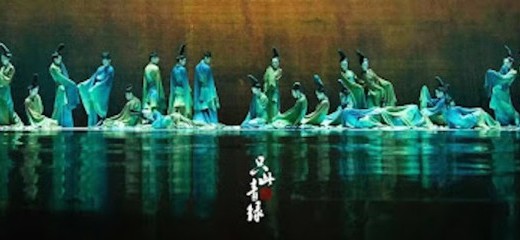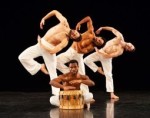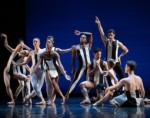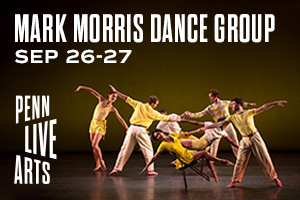
A Glimpse of Traditional Cultural Revival – The Premiere of Chinese Dance Drama in the US
By Ziying Cui
As a dance scholar focusing on examining Chinese dance practices and the hybridity between Eastern and Western cultures in dance, I was thrilled to be able to attend The Journey of a Legendary Landscape Painting (只此青绿;). This two-hour dance drama premiered in Beijing, China in 2021, now makes its US debut in early January of 2025. By describing it as a “poetic dance” in all marketing materials, the production team of the China Oriental Song and Dance Troupe attempts to create a new form of Chinese classical dance that echoes the conciseness and the use of imagery in traditional Chinese poetry. This “poetic dance” has captivated audiences with over 650 performances across China, Singapore, and Turkey, earning widespread acclaim even beyond the realm of dance enthusiasts. Having not returned to China in three years, this New York tour presents a rare opportunity for me to witness the celebrated production. With a mix of curiosity, expectations, and a touch of skepticism, I settle into my seat at the David H Kock Theatre at the Lincoln Center and prepare to experience what had been heralded as reaching “new heights of Chinese aesthetics.”
Directed by two visionary female choreographers, Zhen Han and Liya Zhou, the performance transforms the stage into a living canvas, visualizing the creative process of the iconic Chinese landscape painting, A Thousand Li of Rivers and Mountains (1113) by Ximeng Wang. The narrative unfolds through the perspective of a modern art researcher (Mingqi Xu), who journeys across time to meet the young painter Ximeng (Han Zhang). Through this temporal bridge, the researcher observes the intricate processes behind the creation of the masterpieces. The performance is divided into seven scenes (sections): Unfolding the Scroll (展卷), Tracing the Seal (问篆), Reeling the Silk (for the scroll 唱丝), Pursuing the Stone (寻石) to produce the signature blue-green pigment), Making the Brush (习笔), Grinding the Ink (淬墨), and Into the Painting (入画). While the backdrop projection shows the section titles to remind the theme of each scene, the entire show is produced as a fluent movie without a break.
Unlike many Chinese dance dramas rooted in realist storytelling and dramatic narratives, this “poetic dance” blends abstraction with plot, evoking an artistic realm that transcends image and story. One standout moment in the section Crafting the Brush is a mesmerizing all-female dance that conjures the rolling mountains depicted in the painting. Led by Qingyang Meng, who embodies the character of the Green, the thirteen dancers employ minimalist movements-slightly bending their knees and slowly gliding their feet across the stage.Their dark teal floor-length skirts add a tactile texture to the scene. When lifting their hands in front of their mouths, their light turquoise long sleeves cascade downward like waterfalls. Arranged in a triangle formation, some dancers perform deep, flat backbends while others remain only subtly leaning their torsos backward. Their 10-inch hair buns, inspired by the Tang Dynasty (618-907) hairstyle, further enhance the visualization of undulating mountains.
What augments the audiences’ visual experience is the seamless fusion of traditional Chinese aesthetics and an intricate stage design. A circular mechanical structure suspended above the stage manipulates three massive arc-shaped panels. The panels move up and down to create dynamic space that transforms the proscenium stage. Simultaneously, a multi-layered revolving stage allows dancers to glide without stepping, adding an ethereal quality to their movement. In one poignant sequence, they freeze in place as the turntable gently rotates and an arc-shaped panel descends slowly from above. As the stage lights dim, the dancers disappear behind the panel, evoking the ephemeral passage of time and the transient nature of historical figures. The sophisticated stagecraft, complemented by changing lights and animated projections, enriches the interplay of past and present, tradition and modernism.
The climactic section, Into the Painting, epitomizes the minimalist choreography and visual storytelling. Standing on the central turntable, Ximeng, with a brush in hand, closes his eyes amidst a swelling fusion of drumbeats, piano, and Chinese guqin (a traditional zither). He suddenly executes an airy backflip, his flowing white V-neck robe and wide-leg pants billowing dramatically. As he moves his brush with deliberate grace, male and female dancers in mixed blue-green dresses step onto the outer turntable. With their gaze lowered, they improvise the circulation of their upper bodies, bending torsos forward and back or side to side while moving in harmony with Ximeng’s rhythmic gestures. They become the colors and lines drawn by his brush. At the scene’s peak, the dancers form a line against the backdrop, their leaning, reclining, or kneeling positions embodying the rolling mountains immortalized in the 900-year-old painting.
As the most celebrated Chinese dance drama since the pandemic, this “poetic dance” promotes a revival of traditional Chinese aesthetics through its neo-classical choreography and breathtaking visual spectacle. However, its US premiere also underscores the complexities of intercultural exchange. The exorbitant ticket prices and merchandise costs, the absence of complimentary playbills, and the predominantly Chinese or Chinese American audience demographic raise questions about the production’s claim, echoed by Consul General Chen Li in New York, to serve as a “cultural and artistic bridge between the people of China and the US.”
The Journey of a Legendary Landscape Painting. China Oriental Song and Dance Troupe. David H Kock Theatre Lincoln Center, New York, January 10 to 12, 2025.
*Part 2 of the review is coming in February of 2025.
Homepage Image Description: The image captures an exquisite moment from the poetic dance drama The Journey of a Legendary Landscape Painting. A group of female dancers, dressed in flowing teal skirts and light turquoise tops, perform in perfect synchronization. Their poses, with gracefully bent knees and upper bodies slightly arched, evoke the undulating lines of rolling mountains. The dancers' tall, elegant hairpieces and the mist-like effect on the stage enhance the visual resemblance to a traditional Chinese landscape painting, blending motion with artistic stillness.
Article Image Description: This image showcases a breathtaking tableau from The Journey of a Legendary Landscape Painting. A large ensemble of dancers, clad in flowing blue and green costumes, is positioned across the stage in dynamic, yet harmonious formations. Their fluid movements and graceful postures mirror the essence of a traditional Chinese landscape, with cascading lines that evoke rivers and mountains. The reflective stage floor enhances the ethereal atmosphere, creating a mirror-like effect that doubles the dancers’ artistry and immerses the audience in a dreamlike scene.
By Ziying Cui
February 6, 2025









